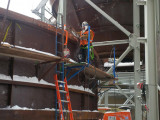Consumers Energy adds spray dry absorbers for SO2 removal
BOILERMAKERS FROM Local 169 (Detroit) are completing work at two Consumers Energy coal-fired power plants in Michigan to retrofit air quality control systems. Work is underway on both sides of the state: at the Karn-Weadock Generating Complex near Bay City in the east, and at the J. H. Campbell complex near Port Sheldon in the west. Both projects involve installing spray dry absorbers to remove sulfur dioxide (SO2) from flue gas before it reaches the stack.
The projects are part of a long-term, $1.5 billion investment by Consumers Energy to meet environmental standards. Local 169 has been part of that effort for over a decade. In 2002 and 2003, lodge members installed selective catalytic reduction units (SCRs) at Karn-Weadock units 1 and 2 to reduce nitrogen oxides or NOx. In 2007, they completed conversion of the J. H. Campbell unit 3 boiler to allow burning 100 percent low-sulfur western coal. The conversion was an enormous project, involving 800 Boilermakers at peak. Past work has also involved installing selective catalytic reduction systems (SCRs, also called “scrubbers”) to remove more than 80 percent of nitrous oxide (NOx) emissions from the flue gas streams.
Work scopes are extensive
WORK AT THE two plants has progressed on separate timetables. At Karn-Weadock, the dry spray absorber system is complete on unit 1, including erection and installation of process tanks and silos, steel support structures, duct work, and assembly and erection of the absorber. Breeching work (tying ducts into the absorber) was completed in March. Similar work is progressing on unit 2, with completion planned for October. The two units have a combined rating of 512-megawatts.
Meanwhile, at J. H. Campbell’s 835-megawatt unit 3, L-169 members have been erecting and installing four bag houses. That work will be followed by the erection and installation of the absorber system.
When operational, the absorber systems at the two plants will inject a stream of lime into the flue gas, which will mix with sulfur dioxide (SO2) to create a solid inert byproduct. The byproduct will be stored in silos and later transported for disposal. Consumers Energy expects the dry spray absorber systems to reduce SO2 emissions by up to 95 percent.
Crews receive praise for performance
BILL NORRIS, CONSUMERS Energy Project Manager for Major Projects and Construction, noted that work at the Karn-Weadock plant required some careful planning, but crews have been up to the task. “There’s quite a bit going on, and everything is complicated with the tight space we have available on site,” he said.
“The trades people are doing a great job for us. We are working with the best of the best. We’re thrilled with the personnel we have; it’s really a neat culture out here. They’ve given us a tremendous effort, and there’s a real focus on quality and safety.”
Local 169 President and Business Representative Mike Card said Boilermakers have excelled at projects for Consumers. “We’ve been on schedule or ahead of schedule, and I don’t think we’ve had a lost time injury since 2010.”
Barton Malow is the contractor for the Boilermakers scope of work at Karn-Weadock, Babcock & Wilcox Power Generation Group for J. H. Campbell.
Source: Marty Mulcahy, The Building Tradesman









